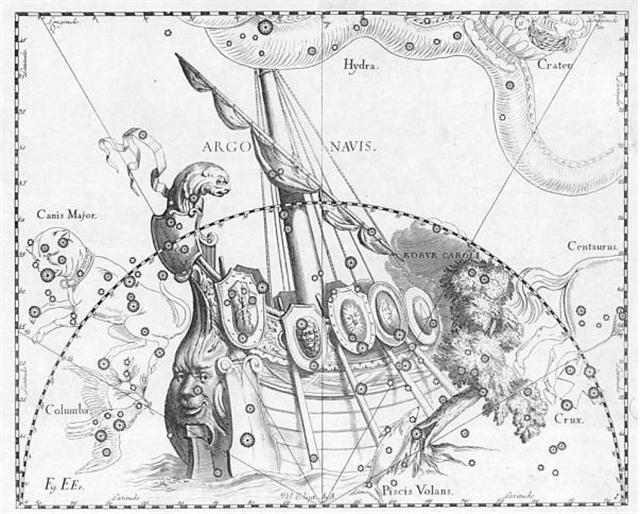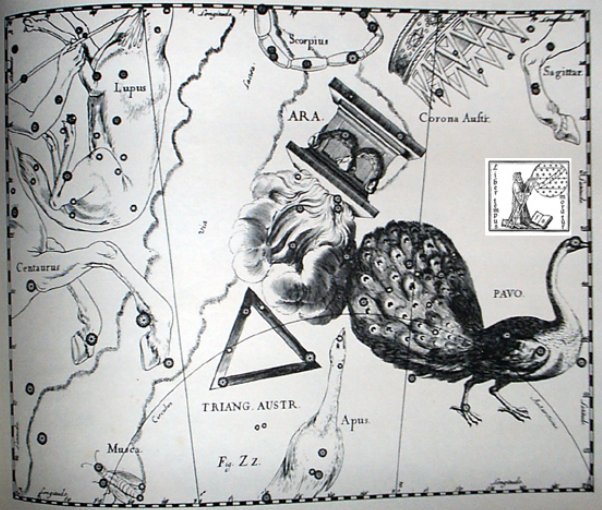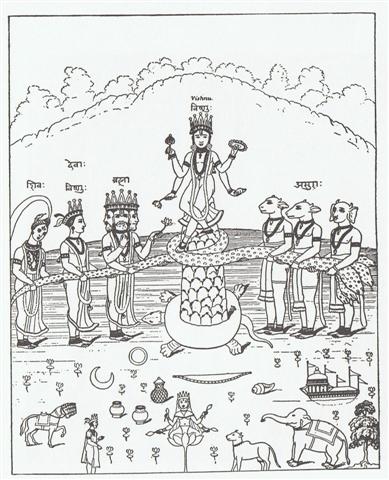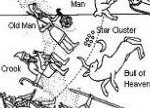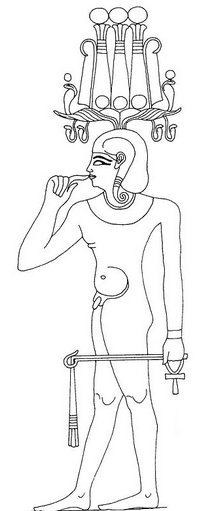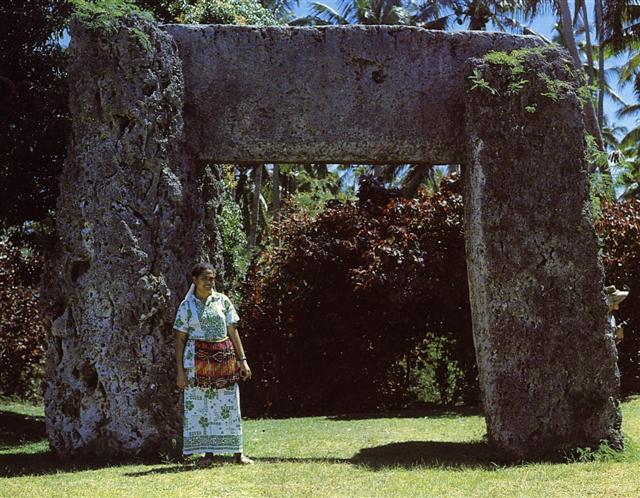17-7. I suggest the creator of the E text also created the G text:
There was a shift in perspective when the precession had moved the cardinal points of the Sun away from the domain of Taurus to that of Aries and further on to Pisces:
... Now Frodhi happened to be the owner of a huge mill, or quern, that no human strength could budge. Its name was Grotte, 'the crusher'. We are not told how he got it, it just happened, as in a fairy tale. He traveled around looking for someone who could work it, and in Sweden he recruited two giant maidens, Fenja and Menja, who were able to work the Grotte. It was a magic mill, and Frodhi told them to grind out gold, peace and happiness. So they did. But Frodhi in his greed drove them night and day. He allowed them rest only for so long as it took to recite a certain verse ... ... Snorri Sterluson explains why 'Frodi's grist' is a kenning for gold. Frodi ruled during a peaceful and productive period, contemporaneous with Augustus's Pax Romana and the birth of Christ; hence the kenning. There were neither thieves nor robbers during this period, 'so that a gold ring lay long on Jalang's heath'. Snorri continues his account with the legend of the mill beyond what is told in the song: The girls' grinding produced an army hostile to Frodi. On the very day of the girls' predictions, the sea-king, Musing (Son of the Mouse), landed on the Danish shore, killed Frodi, and took away Grotti and the women on his ship. The girls were bidden to grind out salt on the mill. At midnight they asked for further instructions. 'Keep grinding', he told them. Then they ground with such vigor that the ship sank. Water poured into the eye of the mill, creating the maelstroem of the sea. Therefore the sea was salt. Incidentally, the mill was given a kenning, Serpent's Couch ...
The difference could be measured as e.g. *54 right ascension days, corresponding to 26000 / 365.25 * 54 = 3844 years. *350 + *54 = *404 = *365 + *39:
227 + 177 = 404. → The distance between Ga1-2 and Gb6-25 (407).
I.e., Elnath would have first moved ahead in the Gregorian calendar with 55 days from "March 6 (31 + 28 + 6 = 65) to "April 29 (31 + 28 + 31 + 29 = 119). And then we could move on from the era of Bharani to the era of Sirrah in order to find the current days:
The star of the Creator (Khnum Khufu) was 2 days further ahead in the Gregorian calendar than Elnath, and likewise it should be in the E text: ... Julius Caesar had determined that the Great Creator (Khnum) - personified by the Egyptian primary god-pharaoh Khufu - should have his culmination night at the place half a year away from 'June 28, where he would lead the triplet ending in day 181 + 183 when Sirius was at the Full Moon ...
The 'Brute' (noa) season of birth (hanau) ended here, with only ashes (te kihikihi) remaining. ... When they were there, and had executed their father's commission, the young men felt a wish to enquire to which of them the kingdom of Rome was to come; and we are told that these words were uttered from the bottom of the cave - 'Young men, whichever of you shall first kiss your mother, he shall possess the sovereign power at Rome' ... Brutus judged that the expression of Apollo had another meaning, and as if he had accidentally stumbled and fallen, he touched the earth with his lips, considering that she was the common mother of all mankind ...
... It is known that in the final battle of the gods, the massed legions on the side of 'order' are the dead warriors, the 'Einherier' who once fell in combat on earth and who have been transferred by the Valkyries to reside with Odin in Valhalla - a theme much rehearsed in heroic poetry. On the last day, they issue forth to battle in martial array. Says Grimnismal (23): 'Five hundred gates and forty more - are in the mighty building of Walhalla - eight hundred 'Einherier' come out of each one gate - on the time they go out on defence against the Wolf.' That makes 432,000 in all, a number of significance from of old. This number must have had a very ancient meaning, for it is also the number of syllables in the Rigveda. But it goes back to the basic figure 10,800, the number of stanzas in the Rigveda (40 syllables to a stanza) [40 * 270 = 10800] which, together with 108, occurs insistently in Indian tradition, 10,800 is also the number which has been given by Heraclitus for the duration of the Aiōn, according to Censorinus (De die natali, 18), whereas Berossos made the Babylonian Great Year to last 432,000 years. Again, 10,800 is the number of bricks of the Indian fire-altar (Agnicayana) ...
... Balancing the notion of tapu, though not in perfect dichotomy, is the notion of noa. This pertains to mundane, ordinary objects and functions - household and serving utensils, the acts of preparing and eating food, the many small and common interactions of everyday life. Noa is safe - without preternatural sanction or restricted association, it is demonstrated by the lifting of the condition of tapu from a particular environment or object. A newly built house, ornamented and fresh, would be considered tapu - unsafe, prohibited, raw with spirit and inaccessible to the common touch of people. Making the place noa - 'blessing' it in current terms - would involve ritual, and the crossing of the threshold, usually by a high-born woman. Her special form of tapu would counter the energies within the house, and thus render it noa, and safe for general entry. Such ritual continues to be observed today; even in the context of an ethnological or fine arts exhibition, these procedures are followed, to appease the ancestral forces who may generate tapu, which imbues the objects with dread or beauty ... As a kind of confirmation I a few days ago noticed that Noa(h) was a name allotted to March 31 in the calendar hanging on my kitchen wall. 90 (March 31) + 64 = 154 (*74, Al-Maaz, Eb7-20).
Inspired by my act of presenting the idea of a common denominator between the E and G texta there are implications gushing forth in my mind. For instance, first of all it explains not only how the pair Eb7-27 and Ga1-4 could be identical:
But it also points at the similarity between these 25 figures in E
Furthermore, 471 (number of glyphs to be counted on the G tablet) + 628 (on the E tablet) = 1099:
Should we count also the hole position after glyph number 260, the number would become a nice 1100. ... About Carmenta we know from the historian Dionysus Periergetis that she gave orcales to Hercules and lived to the age of 110 years. 110 was a canonical number, the ideal age which every Egyptian wished to reach and the age at which, for example, the patriarch Joseph died. The 110 years were made up of twenty-two Etruscan lustra of five years each; and 110 years composed the 'cycle' taken over from the Etruscans by the Romans. At the end of each cycle they corrected irregularities in the solar calendar by intercalation and held Secular Games. The secret sense of 22 - sacred numbers were never chosen haphazardly - is that it is the measure of the circumference of the circle when the diameter is 7. This proportion, now known as pi, is no longer a religious secret; and is used today only as a rule-of-thumb formula, the real mathematical value of pi being a decimal figure which nobody has yet been able work out because it goes on without ever ending, as 22 / 7 does, in a neat recurring sequence [3.142857142857 ...]. Seven lustra add up to thirty-five years, and thirty-five at Rome was the age at which a man was held to reach his prime and might be elected Consul. (The same age was fixed upon by a Classically-minded Convention as the earliest at which an American might be elected President of the United States.) ...
|
||||||||||||||||||||||||||||||||||||||||||||||||||||||||||||||||||||||||||||||||||||||||||||||||||||||||||||||||||||||||||||||||||||||||||||||||||||||||||||||||||||||||||||||||||||||||||||||||||||||||||||||||||||||||||||||||||||||||||||||||||||||||||||||||||||||||||||||||||||||
.jpg)

